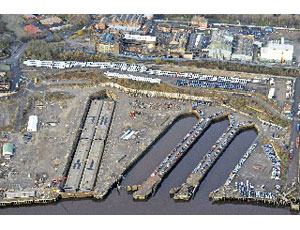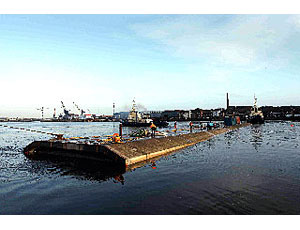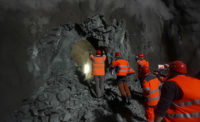With the fourth and last 10,000-tonne concrete element sunk, the U.K.’s new, 1.5-km-long River Tyne Tunnel crossed a major milestone late last month, but a missed dredging window, imposed to protect salmon migration, will cost a delay of two months.


Work now focuses on the final connections between the four 400-m-long concrete elements of the sunken tube tunnel (STT) near Newcastle. The first walk-through is planned for late this spring, says Paul Fenwick, project director at Tyne and Wear Integrated Transport Authority (TWITA).
The overall 2.6-km crossing is part of a 30-year design, build, finance and operate contract, sealed in November 2007. It includes refurbishing the 43-year-old existing crossing, now operating at about 60% over capacity. The TT2 consortium of Paris-based Bouygues Travaux Public S.A. and two U.K. banks raised $370 million to help finance the project. TWITA provided $175 million and operating fees, and TT2 will complete the financing.
For construction, TT2 awarded a $395-million fixed-price, lump-sum design-build contract to Bouygues, which started sitework two years ago. Along with in-house staff, Bouygues used HPR Consultants, London, and the U.K. offices of Aecom Inc. and Parsons Brinckerhoff Inc. for design.
The crossing includes cut-and-cover and sprayed-concrete-lining work on the approaches. Bouygues had planned to minimize disruptive surface approach work by using underground sprayed concrete lining for about 250 m, says project managing director Nicolas Caille. “But the ground was so poor it was decided to extend the cut-and-cover,” adds Caille. Only about 70 m of sprayed concrete lining was used, under large gas and sewer pipes.
The change required building over 45,000 sq m of diaphragm wall up to 33 m tall, says Caille. Bachy Soletanche Ltd., Burscough, also used contiguous piling to form the cut-and-cover walls in its $58-million subcontract.
To cast the 90-m-long, 8.5-m-tall, 15-m-wide sunken tube elements, subcontractor VolkerStevin Marine Ltd., Gateshead, took over a 210-m-long dry dock 3 km upstream. The $24-million subcontract also includes placing the elements and dredging their riverbed trench.
The orirginal plan was to use a floating crane and bucket to excavate 400,000 cu m for disposal at sea, says Caille. But the port authority had the idea of using the material as infill for the dock. The contactor acquired a cutter-suction dredger and piped the fill to the dock.
Securing permits took longer than expected, says Caille. The delay took the project out of the November 2008-March 2009 dredging window. The contractor had to wait a year and started dredging last November.
Bouygues has gained back some lost time, allowing the new tunnel to open next February, only two months late, says Trevor Jackson, TT2’s managing director. But the start date, slated for the end of next year, for full operations on both the old and new tunnels remains unchanged, he adds.
“The biggest challenge has been to keep existing traffic flowing,” says TWITA’s Fenwick. The contractor reconfigured approaches to both tunnels with minimal disruption, he adds.
The DBFO contract imposes no penalties on Bouygues for traffic disruption, says Fenwick. But with operating fees linked to traffic flows, it is in the contractor’s interest to keep cars moving, he adds.
TT2 earns fees linked to numbers and types of vehicles using the tunnels. It now gets 30% of the full shadow toll, which will rise to 40% when the crossing tunnel opens and to 100% when both are in operation.
Jackson’s TT2 team took over operations of the existing tunnel in February 2008, along with about 100 TWITA staffers. The operating culture underwent a “dramatic” change, says Jackson. “People are now [more] aware of costs and contractual arrangements.”




Post a comment to this article
Report Abusive Comment